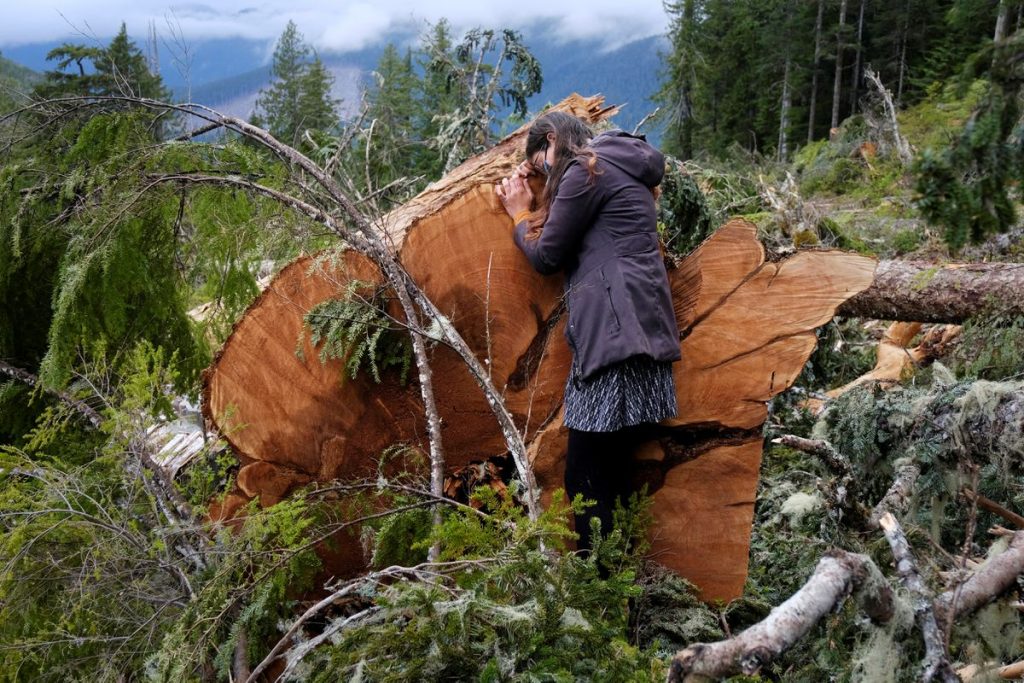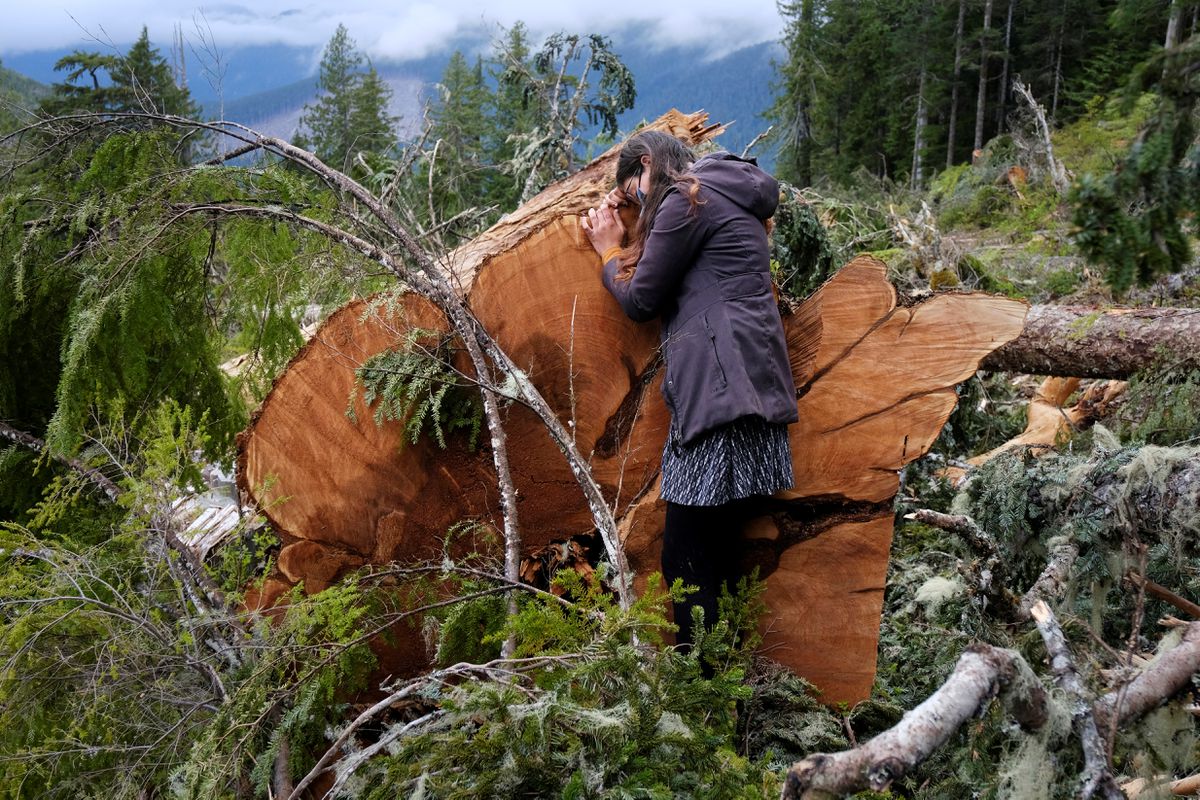UBC professor of forest ecology Suzanne Simard’s work helped to inspire Avatar. Her memoir, In Search of the Mother Tree, is set to become a Hollywood film with Amy Adams playing Simard. The “mother tree” is the tree in ancient forests that communicates with and helps to supply nutrients (including carbon) to surrounding trees via a network of fungi. Because Suzanne Simard’s op-ed is paywalled in the Globe and Mail, we have reprinted it in full here.
The destruction of the last old growth forests has to stop. We must protect the ‘mother trees’
By The Globe and Mail

A woman, who was among activists trying to stop the logging of old growth timber, embraces the stump of a large tree in a cut block of Tree Farm licence 46 near Port Renfrew, British Columbia, Canada on May 17, 2021. JENNIFER OSBORNE/Reuters
Suzanne Simard is a professor of forest ecology in the faculty of forestry at the University of British Columbia and the author of Finding the Mother Tree: Discovering the Wisdom of the Forest. This piece was written in consultation with her colleagues Teresa (Sm’hayetsk) Ryan, Rachel Holt and Tara Martin.
Around the world, mothers are cherished and celebrated for the cycles of birth and nurturing of young lives. Mothers hope above all other things for a happy, healthy life for their children, for future generations.
But mothers today, and their children, fear for the future. Our economic system preferentially degrades nature in favour of expedient dividends for a few, putting us all at risk.
As an ecologist in British Columbia I discovered that trees are connected through below-ground fungal networks and that they communicate with each other and form complex societies similar to our families. After decades of research and hundreds of journal articles published, I have come to understand forests as intelligent systems built on sophisticated relationships with all creatures, including people.
The biggest, oldest trees are mother trees that recognize and nourish their own kin. The interconnected nature of forests has been known for thousands of years by the Indigenous people of North America and the world over that all life is woven together as one.
One time when my daughters were young I brought them to a logging site and we watched the felling of a giant tree.
The thunderous “whomp” of the tree landing on the Earth drowned out the gnawing echoes of the chainsaws that had just severed through her heartwood.
My children and I stood in stunned silence. Her thousand-year old weight crushed her saplings; the needles and cones dropped to the ground. Her roots and their fungal networks that had tied the family together and provided their nourishment frayed and snapped with the weight of heavy machinery.
My oldest daughter stared in shock; my littlest one cried.
We were standing witness to the falling of some of the last of the mother trees, the very life support systems of my children’s future.
It is for this reason that I join my female colleagues, and mothers around the world, in decrying the destruction of the last of the old growth forests.
It must stop.
Forests are being felled at breakneck speed, pumped by a disease of greed and folly, and this is occurring worldwide, not just here in British Columbia.
Many of the tropical rainforests of Borneo, Ghana and the Amazon, the taiga of Russia, and the temperate rainforests of the Oregon Cascades, have already been felled. Even the boreal forest of Canada that grows at glacial speed owing to the high latitude conditions are being clearcut to supply wood pellets to burn in Europe under the guise of biofuels.
Globally, forests represent one-third of earthly ecosystems, store more than four-fifths of terrestrial carbon, and take up one-third of man-made greenhouse gases. The photosynthetic energy they produce drives our biogeochemical cycles: purifying our air, modulating precipitation, and storing organic carbon and nutrients.
These systems exist in a fragile balance that supports life on this one planet, Mother Earth.
Citizens are begging our elected leaders to stop the exploitation, but the ears of politicians are filled with false assurances from corporate heads. They whisper hollow promises of employment even as mills close, jobs are lost to mechanization, and forest companies move elsewhere once the last sticks are cut and the creeks are full of silt.
On southern Vancouver Island at Fairy Creek, people are protesting against complicit government authority, which continues to target the last 3 per cent of the island’s old growth. First Nations who struggle to eke out an economy, deprived from them by colonialism, are given the “Hobson’s choice” of harvesting the last of their own watersheds or watching someone else cut it.
Corporate lobbyists espouse that replacing old-growth forests with new plantations, trillions of new seedlings, will sequester and store more carbon.
This is simply not true.
Half of the carbon stored is lost to the atmosphere almost immediately with clearcutting of old forests, and it takes decades to achieve carbon neutrality, and decades more to recover the sink strength of the original conifer stands.
Climate models show we don’t have decades for these forests to recover. In the hundred years it takes for a forest to mature, our planet will have warmed by upward of 5 C, eliciting mass starvations, migrations and war.
More COVID-like viruses might escape from the spaces of destroyed wild places and infect our populations again and again. The risk of catastrophic fire is amplified as old-growth forests are replaced by monocultures of plantation timber. This is not the future we want to leave our children.
What can be done about this?
First, scientists have evaluated the negative effects from forest losses and these results must be used to inform forest management and protection to reduce the risks. The COVID-19 vaccine is a testament to how rigorous scientific determination and political support can rapidly drive solutions to complex problems.
Just think of what we could do if we focused our attention on solving the climate and biodiversity crises, rather than insisting they don’t exist or treating them as too hard to solve?
Second, strive for a close, protective relationship with nature. Support putting a price on carbon, water degradation and biodiversity loss as an essential step for protecting forests as part of the economic system.
Regulate and monitor the activity of logging companies as conditions of the license to harvest while protecting the integrity of ecosystems and their functions. Those responsible for damages should bear the costs.
Third, take immediate action to protect and restore old-growth ecosystems for their value in storing the greatest amounts of carbon, providing habitat for endangered species and maintaining life-sustaining ecosystem functions and services.
Our relationship with nature is fragile. We are obligated to restore our responsibilities to care for Mother Earth for future generations.
Let us take these steps to ensure that mothers and mother trees can continue to nourish us all.

